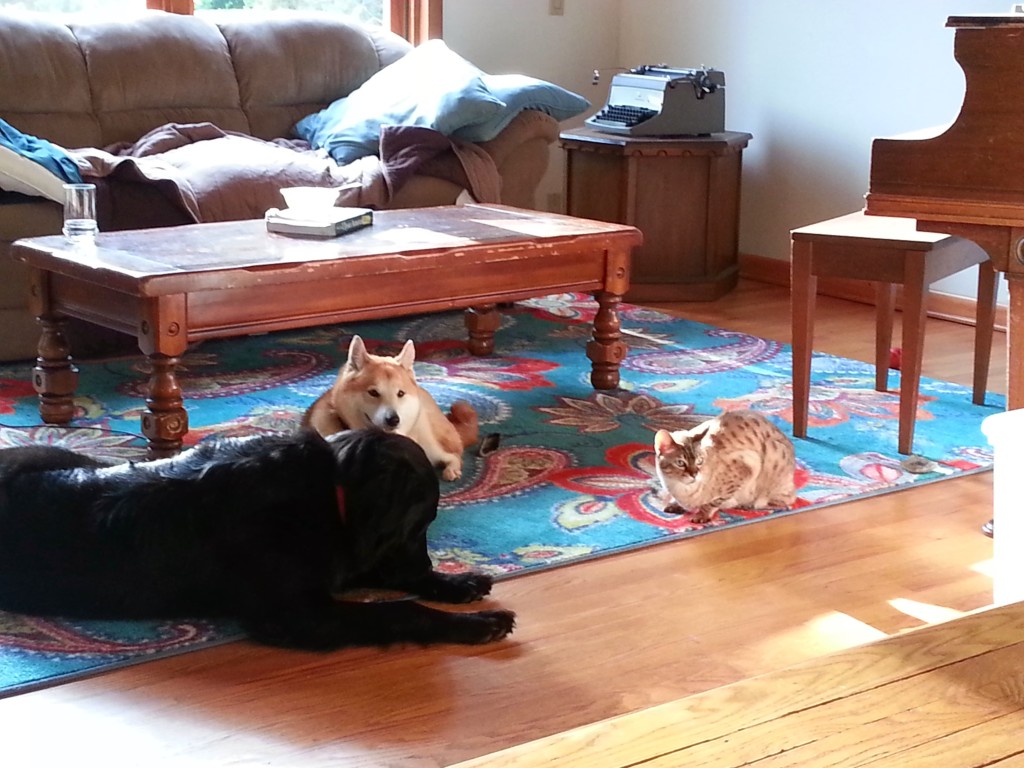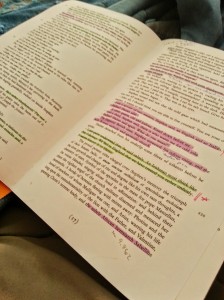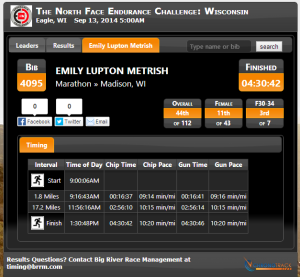 This has been the weirdest “b” race ever, guys. Not only was the training weird, but I tapered for the race, which I never do, and it was a weird taper.
This has been the weirdest “b” race ever, guys. Not only was the training weird, but I tapered for the race, which I never do, and it was a weird taper.
For one thing, it was the only taper in my life that I spent in Europe eating Belgian waffles and French pastries. It was also the only taper (of recent memory) done without a pool available.
Swimming is typically my go-to cross-training because it gives me sexy shoulder muscles, can be done inside (an important consideration this time of year in Wisconsin), and is non-impact. But for this taper at first I was in Belgium and France for two weeks, and while I could have gone over to one of the local pools and gotten a day pass, I was under some obligation to spend time with my family. Anyway, I was walking a ton (it’s Europe), so it didn’t really seem necessary to “work out” outside of my every-other day schedule of running. To keep up my cardio fitness, I ran 8–10 miles at a go every other day, and occasionally did body-weight exercises with B.[1] The day we got back from Europe was the day our gym started its annual cleaning of the lap pool; it reopened the Monday after the race. So I was been totally on my own for the last week.
When a pool is unavailable, there’s always biking. I enjoy biking, sort of. I’m not good at it. So last Sunday after
my run I biked 10 miles to my Chinese class and back (5 miles in each direction to the Social Sciences building—and I got to watch the IM marathon when I was heading home). Monday I biked around some of the rural area outside of Middleton, about 25 miles total. Then Wednesday. . . it was both 45 degrees and raining, so I went to spin class. Friday it was also 45 degrees and raining, so I did more spin. You would not believe (or maybe you would) how energetic one feels when one is in marathon shape, and how difficult it is to get what feels like a good (tiring) workout when you are totally primed to run for four hours without stopping. I guess that means that I had a successful taper because I felt strong and a little crazy.
But still: What is it about spin bikes that no matter how hard I think I’m pedaling, the little odometer always tells me I went 25 miles in an hour? And why can I do only half of that on the mean streets? And why do I sweat so damn much while spinning? And how can I make it stop irritating my bad foot when I stand on the pedals?
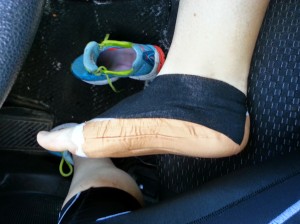
Such questions. I apologize about this blog, by the way. I’ve missed you guys. But here I am almost five hundred words in and I haven’t gotten to the race yet. Also I apologize that I’ve yet to make up my mind about whether I think a colon should be followed by a capital letter (whether or not it introduces a full sentence). I changed the “w” above.
I signed up for this race as a way to gauge my fitness/training before the Antelope Island 50k next month. It also served as my last and longest training run. In a world where I was paying attention to things like having a training plan, my long runs would have gone something like this: (various stuff working up to) 15, 18, 15, 18, 20, 26.2 (and then some taper before the 50k). Instead I have done, starting the first week of July, 17, 13, [10k—tri day], 20, 13, 18, 20, 15, 10, 10. The 15 was the day before I left for Europe, the second 10 was the day after I got back. On the one hand, I actually missed or shortened three of the planned FIVE twenty-milers the plan my friends were following had scheduled. On the other hand, I am not someone who can run over twenty miles a lot and remain uninjured. I am backed up by historical data on this. I need to write myself some reminder post-it notes that say: Don’t do track speed work; don’t wear minimalist shoes; don’t run more than twenty miles once per marathon training cycle (or potentially: don’t run marathons); don’t do two-a-days.
I have done every single one of those fucking things during this marathon training cycle (er, except for the “don’t run marathons” part—though I guess I just did that?), and not surprisingly my right foot is a little angry about it. But not angry enough that I needed to miss the marathon. Just angry enough that I am running on “step down” (which means every other day rather than my normal five days per week schedule), and I had my PT tape my foot on Friday. I’m hopeful I’ll be back in full fighting shape by October, but for now I didn’t have high expectations going into the NFEC. My goals were like this:
- A goal: Sub-4 hours. I was in shape for this, with the exception of my foot that won’t get with the program. If it were a road marathon I would probably expect to clock in right around four hours, even with the issues. However it was a trail race, which means probably not.
- B goal: 4:30:xx. This would be a solid time for a technical trail marathon, and per last years’ finishing times would still put me in the top five women. So it was probably a pipe dream.
- C goal: Sub-5 hours. This was probably a reasonable time given foot and terrain. It would probably be a pretty solid time for this course. (This assumption based on my experiences running elsewhere in the Kettles.)

Writing this introductory portion of the race report the night before, I should note that my week has looked like this:
- Sunday: Run 10, bike 10
- Monday: Bike 25
- Tuesday: Run 10
- Wednesday: Spin class (“25”), aikido
- Thursday: Run 10
- Friday: Spin class (“30”, because I started early)
B looked at this and said, “Have you heard of a taper?” So taper is as taper does, apparently. (Help me out, what does that actually mean?)
The Race
The race had a late start (9:00am) so I was able to sleep in until 6:25 before getting up to begin my pre-race rituals (eat a raspberry Pop Tart while reading The New Yorker). At 7:15 I stuck my stuff in the car. Then I panicked and ran back upstairs for an emergency piece of tape for my foot (in addition to the tape that the PT put on yesterday). I rolled out around 7:20.

The drive over was fine. I felt relaxed. Then after a while I felt tense. I arrived about 20 minutes early and jogged over to the park bathroom (which, by the way, had actual flush toilets and soap!). And. . . my foot didn’t hurt at all. I jogged back to the car. It was still fine. Incredible. I decided to add one more piece of tape to a spot that was sort of bugging me (see picture above). I put on the t-shirt with my number pinned to it while cramming a protein bar in my mouth, grabbed my hydration pack, and set off for the starting line.
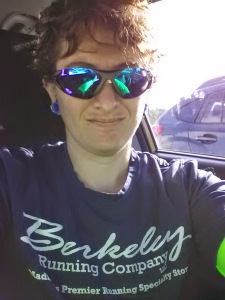
One thing I have to say is that I was impressed by how much parking was available and how close to the starting line I got to park. Another thing that was impressive was how cold it was (about 45 at the start, I’d guess). The race officials had little heat lamps and fire pits for us to warm our hands over.
The race started. I had decided on the following strategy: Run a conservative first half, then pick it up. Walk hills if necessary, and be prepared to hike it in if the foot gives out. So I went out at a pace that felt pretty slow. We ran along the side of a road (Cty Highway ZZ I think) for a while, then turned onto a grassy/muddy path going up a rather mild incline. Later I found out I made it through the 1.8 mi aid station in about 16 min—a 9:16 pace, not exactly relaxed.
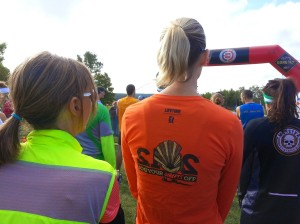
It took me about twenty minutes to get bored. While ultra runners are typically a chatty bunch, road marathoners are often quite serious—they have times to hit, Boston to qualify for, that sort of thing. Well, nuts to that. In what is a giant leap out of my shell, as soon as I came up next to someone who was going my pace, I started chatting with him. He was from Sandwich, IL, a 21-year old guy named Shane who worked as a restorer of houses and was interested in becoming a pastor. We talked for about twenty minutes, then he left me behind and I started talking to a professor of entrepreneurship from Marquette University. He was an interesting guy, had studied classical Chinese back in the day and had a son who was totally fluent in Mandarin.[2] The professor thought he was on track to win his AG (men 64+), so was running a pretty conservative race. I hung with him for about forty-five minutes (through the seven-ish mile aid station and beyond) before he stopped to stretch a calf and I rolled on ahead.
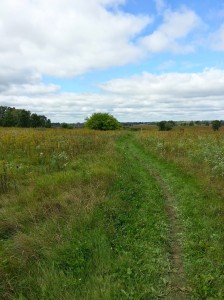
After a few switchbacks we emerged onto the prairie. I met up with two other marathoners, Nicole and Matt, and we chatted through the 11.7-mile aid station. I was still feeling really good at this point—my foot was doing really well on the soft ground (the rain from the last few days proved useful I guess) and I felt strong and happy. I ate a gel at about 1:50:xx and then grabbed some potato chips and a piece of boiled potato dipped in salt going through the aid station; although it wasn’t really a hit-the-salt-hard day, I have been struggling with stomach cramps all summer caused by salt issues, so I decided I wasn’t going to forego it completely.
I lost my companions after the aid station and went on for a while alone. My foot was beginning to bother me, but in truth the pain from the tape rubbing on my skin was worse than anything else. The terrain was very runnable, the weather still comfortably cool. Around (what I think was) mile 17, I passed a guy who made a remark about how he was going to follow me, since I had a good pace going. I laughed and we chatted for most of the next nine miles. His name was Wes; we talked about running, our jobs, his kids, and lots of various sundry things. We also met the single largest climb in the race—it was right around mile 19, and nowhere near as scary as Shane (remember Shane?) had suggested to me that it was. Certainly it was quite steep, and I hiked it rather than try to run it, but it wasn’t super arduous, and I probably could have run it if I’d had a gun on me.
By mile 20, my foot was starting to hurt. And my other foot hurt. And so did my ribs and my abs and. Well, you get the picture. But I knew something was going to hurt. You don’t come unscathed out of a marathon. So onward I went. The terrain had settled down after the big hill and was really pretty easy to run despite my discomfort. As we neared the end (I think close to the two miles to go mark), Wes dropped back to take a gel and I decided to try for some kind of finishing kick.
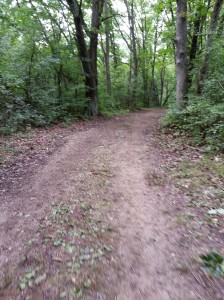
I passed a couple of people (50k-ers and marathon relay people) and started up a really long, low grade hill. This was the point that I tried to speed up and realized how trashed my quads were. I was being passed at this point by a seemingly endless stream of marathon relayers going in the opposite direction and a few coming back. Eventually I crested the hill and tried to push it a bit back to the finish, including passing a lady (50k, sadly, not marathon) in the last fifty feet before the finish. When I turned around, Wes was right behind me—apparently he’d been trying to catch me but couldn’t. We fist-bumped and I wished him well.

I’d finished in 4:30:47 (watch time); I assumed, based on the good (cool) weather and course conditions, that I wouldn’t have placed. But I decided to wander over and get my results anyway before I left. Surprisingly, I was the 11th woman overall, and the 3rd in my age group (of 7). So I hit my B time and still managed to place. Nice. I got a little baggie of prizes, including sleeves, which I am excited to try out sometime this week.
Post-Race
I stumbled back to my car and stopped at a gas station on my way back to Madison for coffee and chocolate milk. I was already sore as I shambled around the store, and things only got worse by the time I got home. But despite my feeling (at the end of the race) that my left big toe was probably bleeding and that my right little toe might have fallen totally off, here is the sum total of the damage:
- Bruise on back from hydration pack
- Sore quads
- Some chafing of various soft tissues
- A blister the size of my thumb under the tape on my right foot
- Everything from the knees down a bit muddy
So that’s not too bad at all. As I write this (following icing and ibuprofen), my foot feels really good (except for the blister). Score one for the PT.
I think that’s all I have to report. For those thinking of doing it, the NFEC is a great course, very runnable but not unchallenging, in a beautiful park, and the race is really well organized. I’m impressed on all counts.
[1] At our last hotel in Brussels, we actually had access to a universal machine in the gym, which was nice but a little confusing—rather than labeling any of the weights as pounds or kilograms, it just said “10, 20, 30” and so on. 20 what?
[2] If you want to be famous, the Chinese seem endlessly amused by Westerners who can speak Chinese fluently. I have never myself been that fluent. Actually, I don’t really understand the draw—as I’ve told some various relatives, there are about 960 million native speakers (as of 2010), making it far and away the most commonly spoken language on the planet. This means that when you learn Chinese, you are doing nothing that has not already been done by LITERALLY a billion people. But the Chinese seem to find it so entertaining! Compare that to Americans, who tend to think that learning English is basically THE LEAST you can do.









